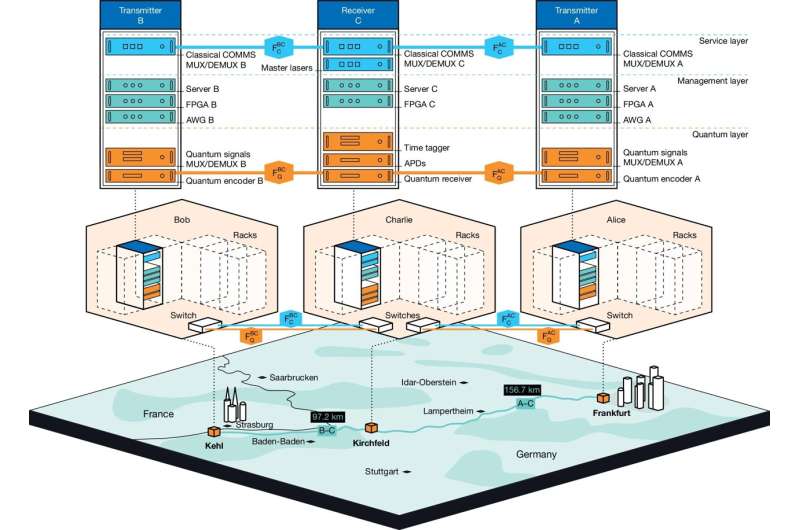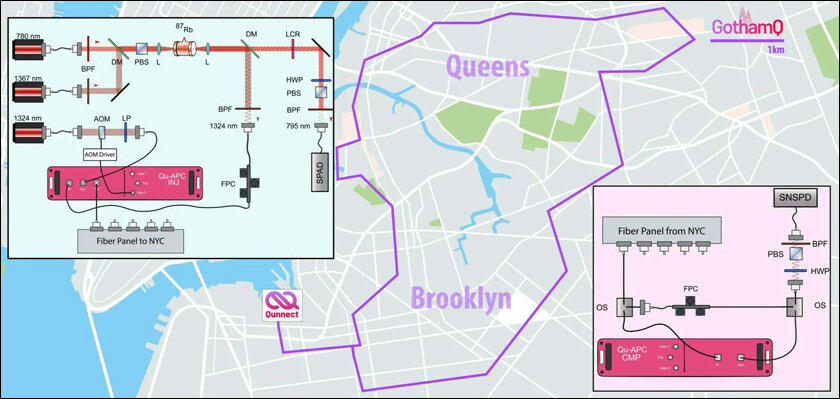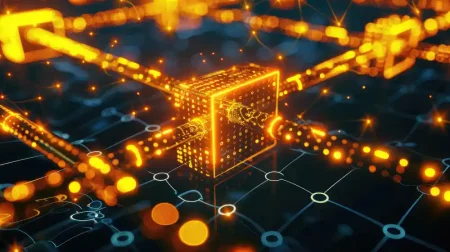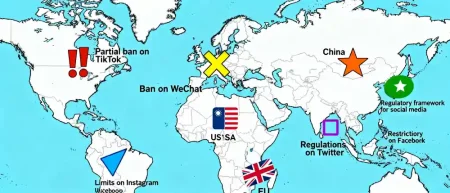Quantum internet isn’t a fantasy – it’s running on the same cables as your WiFi finds Satyen K. Bordoloi as he outlines the breakthroughs forging a path to it.
Even though the digital advances of the last 30 years seem astounding, these will pale once quantum computing joins the innovation chatroom. Slowly, but steadily, thousands upon thousands of scientists worldwide are building that quantum future. A significant achievement in this journey was when scientists transmitted quantum information across 255 km (158 miles) of ordinary fibre-optic cables running beneath German roads.
This feat, led by physicist Mirko Pittaluga and Toshiba Europe, is being dubbed as the first time “coherent quantum communication”—a method leveraging the unique properties of quantum physics for ultrasecure data transfer—has been achieved without costly cryogenic cooling or lab-controlled conditions.

How It Works: Traditional internet data relies on bits (0s and 1s), but quantum communication uses qubits, which can exist in multiple states simultaneously. This enables unhackable encryption keys, as any interception attempt disrupts the quantum state, alerting users instantly. However, transmitting qubits over long distances has required superconducting detectors cooled to near absolute zero, making the technology prohibitively expensive and impractical.
Pittaluga’s team bypassed this hurdle by using avalanche photodiodes—affordable, room-temperature detectors that cost thousands instead of hundreds of thousands of dollars. While these detectors are less efficient and prone to noise (an issue called “afterpulsing”), the researchers deployed a dual-detector system to capture signals and filter out environmental interference. This setup allowed them to relay qubits between data centres in Kehl and Frankfurt via a midpoint detector in Kirchfeld, Germany, using existing telecom infrastructure.

Why It’s a Big Deal: This experiment and a few others have demonstrated that quantum communication can integrate with today’s networks without needing specialised equipment. This paves the way for a “quantum internet” not too far in the future. Such a network would enable hospitals, banks, and governments to share data with a security even the military does not have today.
As quantum computers advance, traditional encryption methods—like RSA—will crumble, leaving sensitive data vulnerable to “harvest now, decrypt later” attacks, where hackers steal data but wait to use it later. Quantum cryptography, by contrast, relies on the laws of physics, not mathematical complexity, making it immune to such threats.
David Awschalom, a physics and molecular engineering professor at the University of Chicago, told The Wall Street Journal that this demonstration was “as real-world as one could imagine.” He predicts metropolitan-scale quantum networks within a decade, transforming industries like banking and finance that rely on secure data.
However, one would suspect that it could happen in under a decade. That’s because this isn’t even the only experiment of its kind.

A Quantum Internet’s Stress Test Under New York: While the German team pushed distance boundaries, a separate milestone unfolded under New York streets in 2024, which I wrote about here. Quantum startup Qunnect operated a 34-kilometre fibre loop (GothamQ) for 15 days, achieving a 99.84% uptime while transmitting polarisation-entangled photons.
Quantum entanglement—Einstein’s “spooky action at a distance”—is a phenomenon where particles get linked so that measuring one instantly determines the state of another, even across vast distances. But maintaining this delicate state in noisy, real-world fibre networks is notoriously difficult. Temperature fluctuations, vibrations, and traffic aboveground can disrupt photon polarisation, breaking entanglement.
Qunnect’s solution was an automated polarisation compensation (APC) system. By sending “classical” reference photons alongside entangled pairs, their hardware continuously measured and corrected for polarisation drift caused by environmental noise. This allowed entangled photons to traverse New York’s fibre network, shared with regular internet traffic, while preserving their quantum states with 99% fidelity, unheard of until then.

A Blueprint for Scalability: That experiment, like this one, prove that quantum networks can coexist with classical infrastructure, avoiding the need for dedicated fibre lines. These are the first times entanglement has been distributed at metropolitan scales with such stability. The results of the New York experiment also suggest that soon, quantum repeaters—devices that extend entanglement over longer distances—could be built using existing telecom networks.
Parallel efforts are underway worldwide. Researchers at Deutsche Telekom Innovation Laboratories (T-Labs) and Qunnect experimented similar to the one under New York, this time in Berlin. They “surpassed previous records for sustained, high fidelity transmission of entangled photons over a commercial fibre network, achieving 99% fidelity over a 30-kilometre distance for 17 days” while simultaneously routing classical data traffic.

If the previous experiments I mentioned talk about quantum internet in existing infrastructure, the actual distance record for quantum communication is held by China. Last October, a small quantum satellite, Jinan-1, established a secure link between China and South Africa ground stations, spanning a record distance of 12,900 kilometres. This experiment used quantum key distribution to encrypt and decrypt data, which showed the potential for a global quantum internet. And the fact that the satellite weighed only 23 kilograms means it’s feasible to launch multiple satellites simultaneously, something akin to Spacex’s Starlink.
Then there is the successful quantum teleportation experiment achieved by a team of scientists at the University of Oxford, who sent a quantum algorithm wirelessly between two separate quantum processors and made the two distant systems interact by sharing logic gates using the principle of quantum entanglement.
Progress on quantum computing technologies is moving fast. Earlier this year, a team created the first operating system for quantum networks. The software can control quantum devices within a quantum network regardless of the type of qubits that make them up.

Toward a Global Quantum Internet: Together, these breakthroughs address two core challenges of a quantum internet: distance and stability. The German and New York experiments show that quantum signals can travel far using affordable and existing hardware while enduring real-world conditions. On the other hand, the Jinan-1 experiment shows that the same can be achieved via satellites. The next step would be to combine all these advances to create hybrid networks that span cities, countries, and eventually continents.
Applications on the Horizon: Quantum internet will change the world in ways we can’t even imagine yet. Consider just a few examples. Banks and governments could use Quantum Key Distribution (QKD)—a secure communication method leveraging quantum mechanics to establish shared secret keys between two parties—to create unbreakable encryption keys to safeguard financial transactions and state secrets.

Distributed quantum computing (DQC), an approach where multiple quantum processors are interconnected and collaborate on complex computations, like the University of Oxford experiment, could exponentially boost their processing power. No problems, from drug discovery to climate modelling, will be too complex for such systems. An interesting application is voting. Quantum-secured networks could eliminate election tampering risks by creating secure voting systems where ballot data remains untappable.
The world has been moving at the speed of science fiction. Star Trek-inspired tap communication took just a few decades to come true through mobile phones. But these experiments in quantum computing and networks threaten to leave even sci-fi behind. Together, they are paving the way for a quantum internet. The dreams of a secure, interconnected quantum world grow closer—one photon at a time.
In case you missed:
- Microsoft’s Quantum Chip Majorana 1: Marketing Hype or Leap Forward?
- Can AI Solve Quantum Physics?
- Google’s Willow Quantum Chip: Separating Reality from Hype
- The Great Data Famine: How AI Ate the Internet (And What’s Next)
- You’ll Never Guess What’s Inside NVIDIA’s Latest AI Breakthrough
- Alchemists’ Treasure: How to Make Gold in a Particle Accelerator (and Why You Can’t Sell It, Yet)
- Are Hallucinations Good For AI? Maybe Not, But They’re Great For Humans
- AI Taken for Granted: Has the World Reached the Point of AI Fatigue?
- Why the Alleged, Upcoming AI Crash Is Never Going To Happen
- AI Adoption is useless if person using it is dumb; productivity doubles for smart humans










